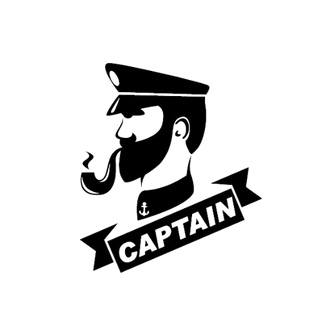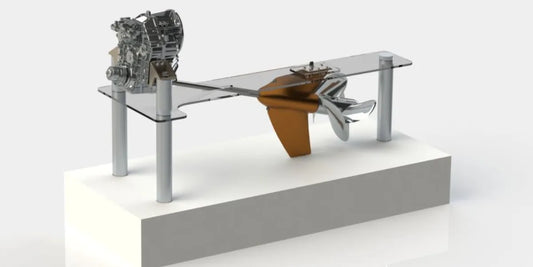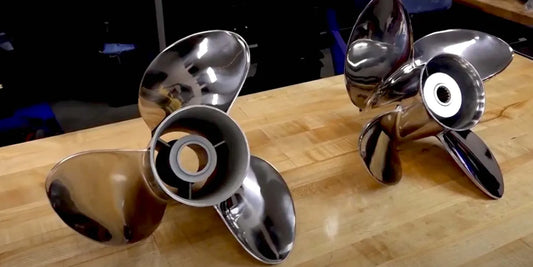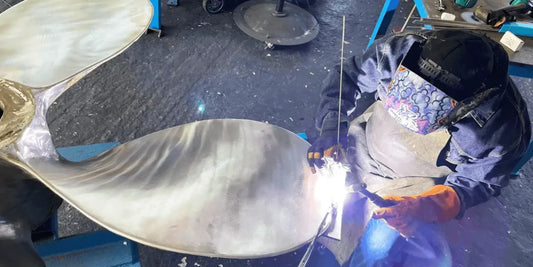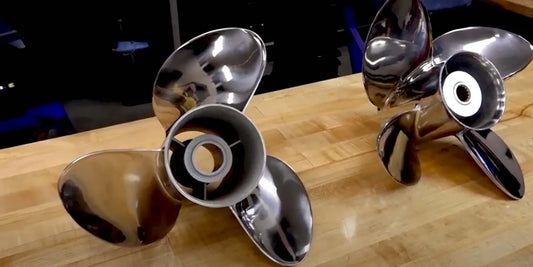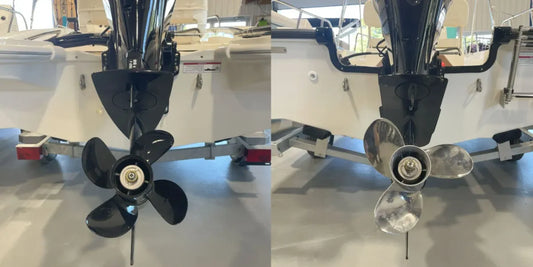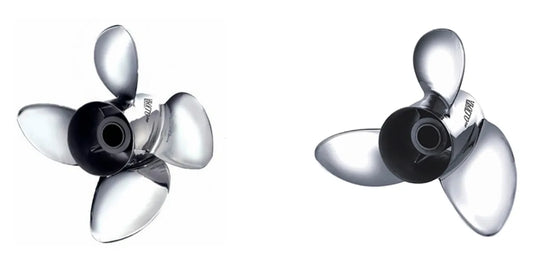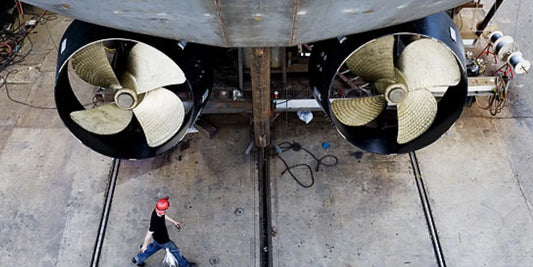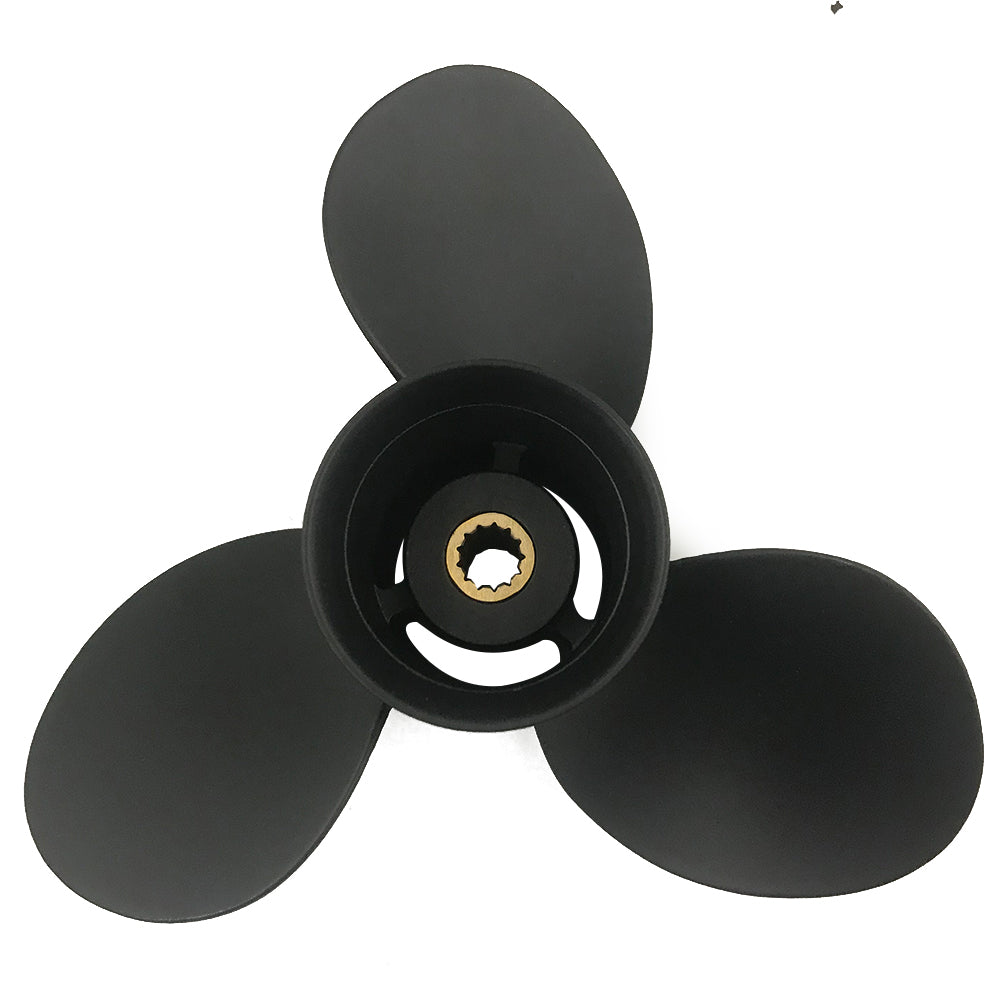Cars are like the lifelines for modern vessels, and amongst the various options available, inboard propellers are the most trusted for their reliability, efficiency, and versatility. Whether traversing calm coastal waters or crossing across the vast ocean, the right propulsion system can make all the difference in terms of faster performance, greater fuel efficiency, and a more satisfying overall experience. This blog ventures inside the world of inboard propellers, teasing out the major advantages, latest applications, and the upward trend in popularity that this technology enjoys in the marine sector. By the time you finish this study, you'd have learned a good deal as to why an inboard propeller could still be treated today as the first big choice of many boating servicemen and amateurs.
Introduction to Inboard Propellers

Meaning and Types of Inboard Propellers
An inboard propeller is simply any propeller installed inside the hull of a boat attached to an engine through a driveshaft. Unlike outboards, inboards keep their lesser components within the actual vessel, bestowing stability and better weight distribution. As a rule, these propellers are more for commercial boating applications such as fishing boats, yachts, and ski boats that require precision and consistency in performance.
Having been designed with particular needs or performances in view, inboard propellers come in several types. Of these, two are most common: the fixed-pitch propeller, which is generally a term referring to a type considered simple and durable since the blade angle is fixed; and the controllable-pitch propeller with the blade angle adjustment in an attempt to gain efficiency under conditions of varying demands. The surface-piercing propeller, in contrast, is meant for high-speed boats, hence every third blade deep into the water with the propeller going through to reduce drag. Each one maintains a very specific use, so inboard propellers can meet a varied range of marine applications.
How Do Inboard Propellers Work?
Inboard propellers generate thrust by transforming rotational energy into linear motion. Essentially, the system comprises an engine, shaft, and propeller. The engine produces power that is transmitted to the propeller shaft, causing it to rotate. By pushing the water aft, the propeller reacts forward with the force that moves the vessel. Contemporary inboard setups place special emphasis on the use of advanced materials and hydrodynamic engineering methods that enhance efficiency while limiting vibrations and fuel consumption. Moreover, the fixed position of inboard drives beneath the hull imparts positive stability and handling. Hence, the inboard type can be seen on many commercial vessels as well as recreational boats.
Key Components: Shaft and Bore
The shaft is one of the elements in an inboard propulsion system through which the engine transmits rotational energy to the propeller. Usually constructed of stainless steel or titanium, the shaft must withstand tremendous torque and resist corrosion in a marine environment. It must be aligned adequately to ensure smooth running and fit all its parts without excessive wear.
The bore, on the other hand, may refer to the exact machining of the shaft or the component associated with it to meet precise tolerances. A perfectly bored bore ensures the correct fit against the shaft, bearings, and hardware. Increasing propulsion with decreasing vibrations and energy loss depicts the harmonious action of the shaft and bore in their corresponding roles, thus giving a petty example of modern precision engineering in an inboard system.
Benefits of Using Inboard Propellers

Enhanced Maneuverability for Inboard Boats
The inboard propeller is designed with special considerations for its working in the handling and control of the boat. The set-up, as opposed to the outboard, allows for a lower center of gravity inside the hull, along with a better weight distribution, which provides more stability during navigation. It is precisely in production turns, docking in tight spaces, and steady coursing on rough water that the arrangement shines. Recent developments in the field have greatly improved inboard propulsion responsiveness and precision-aided for instance by electronic servo rudder systems and electronic throttle control-so that boat operators can confidently carry out delicate maneuvers in no time. Thanks to these design advantages, inboard propellers remain a preferred choice when maximum exteriors for handling and control are needed.
Fuel Efficiency and Performance
Renowned not just for precision handling but also better fuel efficiency and performance are inboard systems. They make the most of an engine's gross power and dispense the least amount of energy in wastage; hence, they are great for longer trips, lessening environmental hazards to some degree in the process. Thanks to improvements in engine technology, such as variable valve timing and enhanced combustion methods, fuel consumption is minimized while power remains the same. Hulls with an inboard propulsion system enjoy the finest alignment for less drag and better hydrodynamic efficiency. This, in turn, means fewer stops for refueling, less operating expenses, and a better experience while cruising.
Durability and Maintenance Considerations
Modern inboard propulsion systems are designed to promote durability and ease of maintenance for long-term reliability of the boat in the owner's possession. Good materials, such as corrosion-resistant alloys and advanced composites, are employed so as to survive marine environments. Meanwhile, in order to extend the life of essential-working parts, things are designed to minimize wear and tear through sealed components or an improved lubrication setup. Furthermore, maintenance-friendly features had been introduced by most manufacturers, such as the inclusion of easily accessible service points and diagnostic systems for quickly pinning down any issues. These developments substantially reduce maintenance interventions, both in their occurrence and complexity, thus affording boat owners more leisure-time opportunities with water-related activities than in repairs.
Popular Inboard Propeller Brands

Overview of Acme Marine Propellers
Throughout its history, the company has prided itself on precision engineering and innovatory manufacturing processes. The company uses the state-of-the-art CNC machining to produce propellers of the greatest quality, which give performance and efficiency to the greatest degree. Acme propellers are designed for smoother acceleration, better fuel consumption, and reliable performance-from top to inboard boats. They build a very wide range of propellers for recreational skiing and wakeboarding to professional water sports. Acme's name is synonymous with durability and excellent craftsmanship in the boating and professional world.
Volvo Penta Inboard Propellers
Volvo Penta inboard propellers are specialized for delivering superior performance to several marine applications. These propellers are very precisely manufactured using advanced technology to maximize thrust, eliminate vibrations, and promote fuel efficiency, hence, a smoother, more pleasant ride. Made out of top-grade raw materials, Volvo Penta propellers have been crafted to endure adverse conditions and to stand the test of time in terms of durability and reliability. Be it for a simple cruise, water sports, or commercial use; these 3-blade inboard propellers can always be relied upon to deliver best performance, perhaps customized to fulfill all kinds of marine purposes.
Comparing 3-Blade vs. 4-Blade Inboard Props
Comparison between 3-blade and 4-blade inboard propellers primarily revolves around performance and application. Generally, 3-blade propellers tend to be preferred if top speeds and cruising speed fuel efficiency are desired. Less drag is produced by such a propeller, thus making it an excellent option for boats striving for speed and less fuel consumption. Yet, in favor of such gains, it may show some deficiency in smoothness of operation.
On the contrary, four-blade propellers provide improved handling, stability, and grip in water. They provide strong thrust and smooth operation, especially in rough or choppy water. Also 4-blade props are considered good for low-speed applications where steady towing power is required, such as water sports or heavier commercial vessels. The somewhat diminished top-end speed of 4-bladers has been more than compensated for by the enhanced controllability and versatility, making it the favored propeller option across a wide array of boats. Ultimately, choosing between a 3-blade and 4-blade propeller comes down to the needs of the vessel and what it will be doing.
Applications of Inboard Propellers in Various Boat Types

Inboard Propellers for Ski and Wake Boats
An inboard propeller for ski and wake boats is offered with the best mechanisms to perform and meet the peculiar needs of the activities. These propellers are specificality engineered to provide the trade- off of speed, acceleration, and power so as to tow skiers and wakeboarders smoothly. The peculiar aspect that descends to the wake is to create as little turbulence as possible so that the quality of the wake is high: a prerequisite for serious tricksters to maintain that quality on the water. Another modern novelty would be to take into consideration fuel diminution and noise suppression in favor of the driver and those being towed. The appropriate selection of an inboard propeller leads to ski and wakeboats performing at an optimum level, allowing for reliability and pleasure when hosting some of the most demanding water sports.
Inboard Propellers Commercial Vessels
Inboard propellers act as fundamental components without which commercial vessels such as cargo ships, fishing boats, and passenger ferries cannot operate efficiently and reliably. These vessels need a powerful propulsion system so that they can bear heavy loads, maintain consistent speed, and maneuver about in different sea conditions. Modern-day inboard propellers are made of advanced materials such as high-strength alloys, which impart durability and corrosion resistance, even in a truly aggressive marine atmosphere. Furthermore, modern propeller designs include improvements in blade geometry and incorporate the latest energy-saving features, further enhancing fuel efficiency and reducing costs for commercial operators. Properly selecting and maintaining these inboard propellers enable commercial vessels to perform better and emit less pollution, thus paving the way for a greener maritime industry.
Selecting the Suitable Propeller for Your Boat Type
Each type of boat has different requirements for an efficient propeller, so picking the right one will ensure enhancement in its performance, fuel efficiency, and the overall handling. Firstly, consider the size and style of the boat, as there are several vessel types-fishing boat, speedboats, cruisers-which will require different propulsion. For example, lightweight speed boats benefit from higher pitch propellers that allow fast speeds, but may not have much low-speed torque. Workboats and fishing vessels, however, tend towards the use of propellers with low pitch so that they can exert more thrust and handling from low speeds when performing towing activities or maneuvering in tight spaces.
Engine compatibility is another foremost factor to consider in order to guarantee proper propulsion and performance. Matching the size of your propeller, in terms of diameter and pitch, with the engine horsepower and corresponding RPM ranges is a very important step. Over an extended period, any lead to inefficient performance either by way of oversizing or undersizing; that is stress upon the engine, though damaging would be another adverse possibility. The number of blades likewise contributes to the equation: a slight increase in speed is usually offered by three blades, while smoother operation and accelerated taking-off become the advantages of four blades-two things a small pleasure boat or the serious working craft can appreciate.
Material choice is a factor in propeller durability and efficiency. The two typical materials utilized in propeller manufacturing have been aluminum and stainless steel. Aluminum propellers are lightweight and cheap, thus preferred for smaller boats and owners with limited budgets. Stainless steel, on the other hand, is used by those who want increased strength and performance, especially in the working environment where the propeller could run into debris or rough underwater terrain. Proper consideration of these should lead you to making the best choice for the needs of your boat, thus allowing for more efficient, safer, and pleasurable boating experiences.
Inboard Propellers for Sale: What to Consider

Factors Affecting Propeller Diameter and Pitch
Diameter and pitch constitute the most common characteristics to ponder when choosing an inboard type propeller; these features directly affect the boat's performance, fuel rate, and handling. The diameter denotes the width of the propeller, seen as if drawing a circle passing through the tips of the blades. If diameter is increased, more power is generally transferred, making its necessity for heavy boats or for vessels needing more thrust at lower speed. Smaller diameters rather tend to give engine efficiency at high speeds, best suited for light go-fast boats.
Pitch measures the theoretical distance that a propeller would traverse in one rotation, assuming that no slippage is occurring. A higher pitch means longer distance covered by the propeller and tendency for quicker speeds but could be a source of strain on the lower-power engines. Low-pitch propellers, though resulting in slower top speeds, provide faster acceleration, better handling, and towing mechanics on congested waters.
Balancing diameter and pitch is very important; any mismatch will bring about fast wear of the engine, bad fuel consumption, or loss of top-end performances. Considering the particularities of your boat—the weight, engine power, use—the propeller setup that suits best will allow it to perform well and last long.
Where to Look for a Good Inboard Boat Propeller
When searching for a good inboard boat propeller, I would suggest first focusing on well-known marine supply organizations and specialist dealers. Websites like West Marine and Fisheries Supply will cover a broad spectrum of choices for inboard propellers, depending on the size of the boat and the performance need. These sites usually offer detailed descriptions of the products, reviews by other customers, and knowledgeable customer service to assist you in making a good decision.
Another equally excellent opportunity is to check out manufacturers' websites like Michigan Wheel or Mercury Marine, which produce high-performance propellers with longevity and efficiency in mind. Several of these manufacturers offer useful tools, such as online propeller selectors, aiming to help you identify the suitable propeller that fits your boat's specifications. Local marine servicing businesses keep your options open for expert advice, focusing strictly on your vessel's needs.
Last but not least, the online harbor is rich with marketplaces, e.g., Amazon and eBay, which have a plethora of inboard boat propellers. One track I would advise you to take is checking the ratings and reviews from previous buyers for assurance of the products' genuineness and quality. Wherever your trip leads you, ensure to use the time to do proper research and compare all available options for your steamer's smooth operation and maximum performance.
Tips for Purchasing New Inboard Propellers
Boat-specific requirements always form my first step in the choice of new inboard propellers. It is important to know about the engine horsepower and also the hull type, along with the general idea of the utilization of the boat, i.e., whether it is for cruising, fishing, or water sports. Factors such as size and pitch should be taken into consideration concerning propeller selection as they weigh heavily on mannerism, fuel consumption, and handling. I always refer to my owner's manual or ask the manufacturer for the proper specifications applicable to the requirements of my boat.
Another consideration is the material of the propellers. Stainless steel propellers are highly durable and possess a high personality, especially at high speeds, but they can be rather expensive. Aluminum propellers, meanwhile, are more pocket-friendly and light, which, for a casual boater, is a nice bonus. I weigh my options based on my budget and what I plan to do with the propellers. Advice from experts or even from other seasoned boaters can help narrow down the decision when I'm uncertain about a particular choice.
I also look very closely at ratings and reviews when buying online or in an actual store. Obviously, customer reviews speak of a propeller model's real life performance and possibly of issues faced. I usually like to purchase from trustworthy retailers or directly from the manufacturer, so that I can be confident in receiving genuine goods of good quality. Whether I buy online or in the real world, the whole process of option comparing, questioning, and back-checking about compatibility either for myself or for an expert has really paid off in keeping my boat running smoothly and efficiently.
Reference Sources
-
West Marine - Guide To Propellers For Inboard Boat Motors
This guide provides insights into the safety, reliability, and performance enhancements offered by inboard propellers. -
GetBoat Blog - Inboard Boat Propellers: Guide to Choosing the Right Propeller
Discusses how a well-matched inboard propeller can optimize speed, efficiency, and overall boating experience. -
Deep Blue Yacht Supply - What are inboard boat propellers
Explores the various applications of inboard propellers, including fishing, cruising, water skiing, and more.
Frequently Asked Questions (FAQs)
What are the advantages of using 4-blade inboard propellers?
A 4-blade inboard propeller provides more thrust and better handling than its 3-blade counterpart. The extra blade improves propulsion efficiency, so such props are preferred for quite heavy boats or when heavy acceleration is required; they will also impart less vibration. Less vibration should translate into better of fuel consumption, saving money in the long run, something to consider for high-performance vessels. Practically, the 4-blade would translate to an extremely smooth ride with reliable operation. Many 4-blade propellers are made from materials like Nibral or stainless steel, which offer resilience against wear and enhanced service life.
What diameter should I pick for my inboard boat prop?
The diameter of the inboard prop of the boat is most critical in attaining the best performance and efficiency. To gauge the diameter of the prop, one must take into consideration the horsepower of the boat's engine, its weight, and the job it has to accomplish. A bigger-for-diameter prop creates more thrust but demands more power from the engine, which in turn can affect its performance. The smaller-gauge diameter can act better on acceleration but put a stop to higher speed. It is best to get a marine expert or check with the manufacturers of your boat to obtain recommendations on prop diameter best suited for your particular setup.
What is setting one apart: the left or the right inboard propeller?
Left-hand (LH) and right-hand (RH) inboard propeller are terms used by mariners to designate the direction of rotation, as seen from the stern. LH propellers rotate counterclockwise and RH ones clockwise. Choosing one of these, LH or RH, is necessary for balancing and controlling a twin engine, or in times when one of the setups undergoes wear of any sort. However, in the end, match the rotation of your prop with the rotation given to a propeller by the engine for best performance and never create any problems for operation. There are answers to deriving the proper choice of propeller by seeing what's on the boat now or simply by consulting with a pro.
How does one go out and obtain one of those inboard propellers for sale?
The supply of inboard propellers is vast; there are many marine supply stores and Internet shops. Websites dedicated to marine equipment generally offer different sizes and types of inboard propellers by well-known companies such as Michigan Wheel and Veem. Local marine supply stores usually furnish a number of new and used inboard propellers newer, and one may be able to inspect them before making a final purchase. Price comparison and product reviewing will lead to a proper bargain. Custom-made inboard propellers may be purchased directly from some manufacturers, as well.
What, indeed, are the materials inboard propellers are made of?
Downtime propellers can be manufactured out of many materials. The common reference is stainless steel and bronze. Stainless steel propellers have the required strength and corrosion resistance to be used in saltwater; bronze propellers are highly wear-resistant at a relatively cheap price. Nibral, the nickel-bronze aluminum alloy, combines the advantages of the two and is among those used in certain high-performance applications. There is also some subtle but important difference in size and weight between the different materials, thus affecting slightly the efficiency of the propeller. Hence it's best to decide on your propeller with respect to your sailing conditions.
How does the number of blades affect the performance of an inboard propellerless engine?
The more blades there are, the better the performance will be. This generally means blades offer more thrust and smoother operation at low speeds. Viewing it from an operational standpoint, three-bladed propellers are preferred to be mounted in inboard boats like motor yachts due to their maneuverability and acceleration, whereas four-bladed propellers can be the good compromise that offers more thrust at low speeds; however, these typically tend to go slower than the three-bladed ones because of drag against it. So, if you require top speed or highest maneuverability, based on the mode of application of your boats, you will have to select among both types of configurations.
